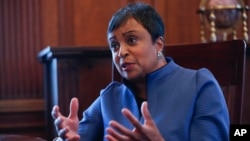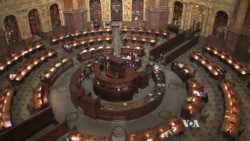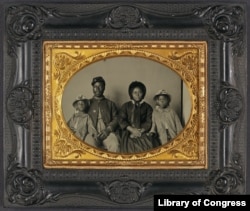As riots convulsed the city of Baltimore, Maryland, in 2015, Carla Hayden kept a library in the heart of the chaos open. She says people in the neighborhood lined up outside the library to get in, even as a drugstore across the street was being looted and burned.
“The people did not touch the library, because it was the resource center in that community,” Hayden told VOA. “It’s beloved. It is protected. It is the place of hope in a community that needs hope.”
One year later, President Barack Obama elevated Hayden from her post as CEO of Baltimore’s Enoch Pratt Free Library to head the Library of Congress, which was established more than 200 years ago as the research arm for congressional officials.
Hayden has made history as the first woman Librarian of Congress as well as the first African-American. And unlike the mostly politicians or academics who came before her, she is a professional librarian.
She took over an institution that has been criticized, in recent years, for mismanagement, a lack of leadership, and falling behind in technological advances.
Hayden’s focus is on upgrading the library’s technology to make the eclectic mix of 160 million items — from books and photos to sheet music and maps, even baseball cards — available to people everywhere.
“I want the Library of Congress to open its arms to people around the world, to let people know it is available to them,” said Hayden, who colleagues say is warm and determined.
Library’s collections
Considered America’s library, the Library of Congress contains more than 30 million books and print materials from around the world in more than 450 languages. It houses a 1400s Gutenberg Bible, and owns the world’s largest comic book collection.
While the public can view materials in reading rooms, they cannot check them out. Because the materials can’t be checked out, Hayden wants to make the library materials, especially those online, more accessible and interactive by using the latest technologies.
“We have things on our website that bring the collections to people wherever they are,” she said. “They can download materials, and participate in a 3-D virtual reality tour of the library.”
Hayden sees herself as “getting on the train that had already been started in the 1990s,” when the library first began digitizing its items. She is now developing a digital strategy to significantly increase the amount of online content.
She says the volume of items the library receives is enormous, with at least 10,000 items added to the collections every day of the workweek.
Connection with books, libraries
During an interview with VOA, Hayden, 64, held her favorite book, Bright April, which she recalls checking out of a library when she was about 8. It’s about a young African-American girl who is a Brownie, a younger level of a Girl Scout, and experiences racial prejudice.
Hayden says she identified with the moral of the story — that even though people are different on the outside, they are the same on the inside.
“I thought this little girl just reflected me,” she said.
Her love for that book, and many others, propelled Hayden to become a children’s librarian. She also became chief librarian for Chicago’s public library and the president of the American Library Association. By working in libraries with diverse patrons, she learned that it’s important to “recognize the cultural heritage of the neighborhoods.”
Traveling exhibits
Besides increasing online services, Hayden wants to make Library of Congress materials available through traveling exhibits, especially beyond city limits.
“The library is working on re-establishing a mobile service, taking an 18-wheeler truck and loading it up with facsimiles, sometimes with electronic information and devices, to help people connect with the Library of Congress directly,” she said.
Hayden has a proven record of expanding outreach programs and technology in libraries.
More than 20 years ago, she paved the way for Baltimore’s public library system to become the first in Maryland to provide internet access.
Now she wants to ensure that millions of items in the world’s biggest library are accessible to everyone.








![Portrait of Ella Fitzgerald, Dizzy Gillespie, Ray Brown, Milt (Milton) Jackson, and Timmie Rosenkrantz, Downbeat, New York, N.Y., ca. Sept. 1947] Music Division, Library of Congress. William Gottlieb, photographer.](https://gdb.voanews.com/47AC6A63-1871-47CB-B240-595CACC4715A_w250_r0_s.jpg)





